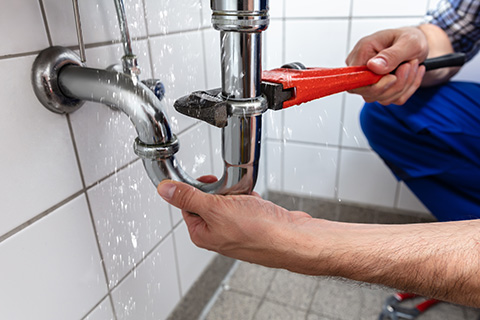If you’ve got some DIY skills, they can really come in handy during a plumbing emergency. Plumbers know their stuff, but they can be pricey and might not be available right away, especially when they’re super busy.
Picture this: a water leak that’s making your bill skyrocket, and the plumber can’t get to you for days. If you know how to do a few simple fixes, like stopping a leaky tap or handling a small pipe issue, you can sort things out fast and save some cash.
Just remember, if things get too tricky, it’s time to call in the pros to avoid making it worse.
Assessing the Situation
First, take a look at what’s going wrong with the plumbing to see how serious it is. Is it just a tiny leak under the sink, or is it a big mess like water shooting out from a busted pipe inside a wall?
Figuring out how bad it is helps you decide what to do next and gets you ready for the job. Snapping a few photos or a quick video can be super helpful when you need to explain the problem to a plumber later.
Also, listen for weird noises or notice where water’s gathering—these details can be super important.
Staying calm is key. Freaking out can mess with your thinking and lead to bad choices. Problems like toilets overflowing or drains getting clogged need quick action.
Spotting these issues fast can stop more damage, save cash, and keep things under control. A good check-up not only makes for speedy repairs but also stops things from getting worse.
Essential Tools and Materials
Having the right tools handy can turn a scary plumbing problem into a simple fix. Every homeowner should think about having a basic plumbing kit for emergencies.
Stuff like a plunger, an adjustable wrench, and some pipe tape are must-haves for stuff like clogs and leaks. These tools help you fix things fast, cutting down on water mess and stress.
Also, it’s a good idea to have rubber gloves, towels, and buckets around for cleaning up spills safely.
Having a set plumbing kit means you’ll know exactly where everything is when you really need it, which saves a lot of time.
Make sure you know how each tool works; it helps you avoid mistakes and feel more confident when fixing stuff. Spending a bit more on good tools is smart because they last longer and work better, so you won’t need a plumber as often.
Being ready not only makes plumbing problems less stressful but also makes you good at handling small repairs yourself.
When to Turn Off the Water
When you’ve got a plumbing emergency on your hands, knowing when to turn off the water is key. It can stop a small problem from turning into a big mess.
If you’ve got a burst pipe or a big leak, you’ve got to act fast to stop serious water damage. Find your main stopcock—usually it’s near the water meter or where the water comes into your house.
It might have a round or lever handle; just turn it clockwise to shut off the water. Also, check out the smaller valves under sinks or behind toilets, which can stop water to certain spots.
Label these valves clearly so you can find them easily when things go wrong. Practicing how to turn them off before something happens can really help you stay calm and handle things quickly.
By shutting off the water right away, you can cut down on damage and avoid pricey repairs and insurance headaches. This simple step is super important for handling plumbing problems and keeping things under control at home.
Being ready like this is just good British practice for any plumbing issues that pop up.
Safe DIY Techniques
Doing your own plumbing at home can be a smart move, but you’ve got to be ready and careful. Before you start, grab some gloves, goggles, and sturdy shoes to keep safe from spills and sharp bits.
Got a blocked drain? A plunger is your best mate. Make sure it fits right over the drain and use firm, steady pressure to shift that blockage.
If something’s leaking, use an adjustable spanner to tighten it up, but be gentle—don’t overdo it and break something.
Keep things tidy and take notes or photos as you go. It’ll be handy if you need to call in a professional plumber later. You can also check out online tutorials for a bit of visual help if you’re stuck.
Stay calm and take your time with plumbing tasks. Safety first, as you don’t want to mess up your home or hurt yourself.
By being careful and patient, you’ll finish the job safely and maybe even pick up some new skills. Playing it safe not only solves your plumbing problems but also makes you better at DIY over time.
Common Mistakes to Avoid
Jumping into plumbing repairs without a plan can make things worse. It’s smart to know what common mistakes to avoid. A big one is using too much force or the wrong tools.
Like, if you try to loosen a fitting with too much muscle, you might break it. Instead, pick the right tool and apply gentle, steady pressure.
Be careful with chemical drain cleaners; they can mess up your pipes and aren’t great for your health either. Safer options? A plunger or a drain snake. They clear clogs without all those nasty chemicals.
If you’re dealing with big problems, like major leaks or sewer backups, trying to fix these on your own can cause more trouble. Sometimes, it’s smart to call in the pros.
It’s also super important to keep your cool; taking breaks can help you avoid hasty mistakes. Always double-check your work, as missing a loose joint could lead to leaks and bigger issues.
By knowing and steering clear of these mistakes, you can slowly get better at DIY, saving time and money. Being careful and aware really pays off with any DIY project.
When to Call a Professional
Knowing when to call a plumber is key to keeping your home’s plumbing in good shape. You can handle small fixes yourself, but sometimes you need a pro.
If you’ve got leaks or damp spots that just won’t go away, it might be a sign of a bigger issue. Don’t ignore them, or you might end up with water damage, mold, or even messes with your house’s structure.
If you spot mold or notice your house seems to be shifting, it’s time to call in an expert.
Big repair jobs or sewer problems are usually not the kind of thing you want to tackle on your own. Plumbers have the right tools and know-how to handle these tough jobs safely.
If a problem seems too big to handle, it’s a good idea to get a professional to make sure it gets sorted out right.
Having a list of good local plumbers can save the day in an emergency. Being prepared like this can protect your plumbing and save you from big repair bills and stress.
Knowing when to get a professional involved keeps your home safe and gives you peace of mind about your plumbing.
Conclusion
Plumbing problems aren’t as daunting if you’ve got the right skills and tools. First, check the situation, use the right tools, and know when to turn off the water.
You can handle small issues on your own, but it’s best to call a professional if things get complicated. Keep basic tools handy and stay calm. Safety first in any DIY task, so catch big problems early.
Be prepared for any plumbing issues that come up. Always ready? Grab your tools and give it a go!




